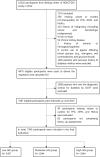High hemoglobin glycation index is associated with increased risk of diabetes: A population-based cohort study in China
- PMID: 36909319
- PMCID: PMC9999023
- DOI: 10.3389/fendo.2023.1081520
High hemoglobin glycation index is associated with increased risk of diabetes: A population-based cohort study in China
Abstract
Purpose: The hemoglobin glycation index (HGI) quantifies the mismatch between glycated hemoglobin A1c and average glycemia among individuals. Currently, it is unknown the potential role of HGI in exhaustively evaluating the progression of glucose metabolism/the risk of developing diabetes mellitus. Therefore, this study aimed to investigate the association between HGI and the risk of incident diabetes.
Methods: A total of 7,345 participants aged at least 40 years and without diabetes were divided into three groups according to the tertile of their baseline HGI level and followed for a median of 3.24 years to track new-onset diabetes. Using multivariate Cox regression analyses, we explored the association between the HGI, both categorized and continuous, and incident diabetes.
Results: During follow-up, 742 subjects (263 males and 479 females) developed diabetes mellitus. Higher HGI was associated with an increased risk of diabetes, even when adjusted for confounding factors, and every standard deviation increase in HGI was associated with a significant risk increase of 30.6% for diabetes (hazard ratio 1.306, 95% confidence interval 1.232-1.384).
Conclusions: Participants with a higher HGI were at a higher risk of future diabetes, irrespective of their glycemic conditions. Consequently, HGI may be employed to identify individuals at high risk for diabetes.
Keywords: biological variation; diabetes mellitus; glycated hemoglobin A1c; hemoglobin glycation index; risk factor.
Copyright © 2023 Lin, Wang, Jia, Wang, He, Mu and Dou.
Conflict of interest statement
The authors declare that the research was conducted in the absence of any commercial or financial relationships that could be construed as a potential conflict of interest.
Figures




Similar articles
-
Association between hemoglobin glycation index and diabetic kidney disease in type 2 diabetes mellitus in China: A cross- sectional inpatient study.Front Endocrinol (Lausanne). 2023 Mar 8;14:1108061. doi: 10.3389/fendo.2023.1108061. eCollection 2023. Front Endocrinol (Lausanne). 2023. PMID: 36967789 Free PMC article.
-
Haemoglobin glycation index and in-hospital mortality after acute myocardial infarction in patients with/without diabetes: A prospective, nationwide and multicentre registry.Diabetes Obes Metab. 2025 Aug;27(8):4511-4521. doi: 10.1111/dom.16495. Epub 2025 Jun 3. Diabetes Obes Metab. 2025. PMID: 40459018
-
Hemoglobin glycation index and neutrophil percentage as predictors of congestive heart failure among individuals diagnosed with sepsis: A MIMIC-IV cohort study.Sci Rep. 2025 Jul 25;15(1):27099. doi: 10.1038/s41598-025-12453-1. Sci Rep. 2025. PMID: 40715448 Free PMC article.
-
Hybrid closed-loop systems for managing blood glucose levels in type 1 diabetes: a systematic review and economic modelling.Health Technol Assess. 2024 Dec;28(80):1-190. doi: 10.3310/JYPL3536. Health Technol Assess. 2024. PMID: 39673446 Free PMC article.
-
Quality improvement strategies for diabetes care: Effects on outcomes for adults living with diabetes.Cochrane Database Syst Rev. 2023 May 31;5(5):CD014513. doi: 10.1002/14651858.CD014513. Cochrane Database Syst Rev. 2023. PMID: 37254718 Free PMC article.
Cited by
-
Serum magnesium and calcium were inversely associated with hemoglobin glycation index and triglyceride-glucose index in adults with coronary artery disease.Biol Trace Elem Res. 2025 Mar;203(3):1422-1430. doi: 10.1007/s12011-024-04287-1. Epub 2024 Jun 24. Biol Trace Elem Res. 2025. PMID: 38913294
-
Association of hemoglobin glycation index with all-cause and cardio-cerebrovascular mortality among people with metabolic syndrome.Front Endocrinol (Lausanne). 2024 Nov 29;15:1447184. doi: 10.3389/fendo.2024.1447184. eCollection 2024. Front Endocrinol (Lausanne). 2024. PMID: 39678188 Free PMC article.
-
Remnant cholesterol, but not other traditional lipids or lipid ratios, is independently and positively related to future diabetes risk in Chinese general population: A 3 year cohort study.J Diabetes Investig. 2024 Aug;15(8):1084-1093. doi: 10.1111/jdi.14205. Epub 2024 Apr 3. J Diabetes Investig. 2024. PMID: 38568177 Free PMC article.
-
The Association Between the Hemoglobin Glycation Index and Cardiometabolic Diseases: A Mini-Review.J Clin Hypertens (Greenwich). 2025 Jul;27(7):e70092. doi: 10.1111/jch.70092. J Clin Hypertens (Greenwich). 2025. PMID: 40662995 Free PMC article. Review.
-
Impact of hemoglobin glycation index on prognosis in critical patients with acute ischemic stroke: A retrospective cohort study using MIMIC-IV 2.2 database.Sci Rep. 2025 Jul 2;15(1):23095. doi: 10.1038/s41598-025-07833-6. Sci Rep. 2025. PMID: 40595190 Free PMC article.
References
-
- Chinese Diabetes Society . Guideline for the prevention and treatment of type 2 diabetes mellitus in China (2020 edition). Chin J Diabetes Mellitus (2021) 13(4):315–409. doi: 10.3760/cma.j.cn115791-20210221-00095 - DOI
MeSH terms
Substances
LinkOut - more resources
Full Text Sources
Medical

